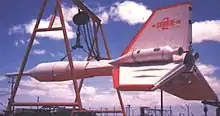Skokie (rocket)
Skokie was a family of research vehicles developed by the Cook Electric Co. for the United States Air Force during the mid to late 1950s. Launched from a B-29 bomber, Skokie 1 was an unpowered, ballistic vehicle, while Skokie 2 was rocket-propelled; both were used for evaluating and testing high-speed parachute recovery systems.
 Skokie 2 | |
| Function | Experimental rocket |
|---|---|
| Manufacturer | Cook Electric Co. |
| Country of origin | United States |
| Size | |
| Height | Skokie 1: 7.6 metres (25 ft) Skokie 2: 9.8 metres (32 ft) |
| Diameter | Skokie 1: 510 millimetres (20 in) |
| Mass | Skokie 1: 1,100 kilograms (2,400 lb) Skokie 2: 1,400 kilograms (3,000 lb) |
| Stages | One |
| Launch history | |
| Status | Retired |
| First stage – JATO | |
| Engines | 3 |
| Thrust | 49 kN (11,000 lbf) each |
| Fuel | Solid |
Design and development
Intended for use in evaluating high-speed parachute systems for the recovery of missiles and unmanned aircraft,[1] Skokie was a simple, inexpensively-designed vehicle, consisting of a tube with a long spike on the nose to reduce damage while landing under parachute.[2] Named after the hometown of the Cook Electric Co., their manufacturer,[3] Skokie 1 had four aft-mounted stabilizing fins;[4] Skokie 2 had a tri-fin arrangement,[5] with three solid-propellant rockets, of a type similar to that used for rocket-assisted take offs, externally mounted between them.[2] The vehicle was equipped with instrumentation to record the deployment of the two-stage parachute; a high-speed camera was also fitted.[5] Skokie I descended ballistically at high subsonic speed; the rocket-powered Skokie II could reach Mach 2 before deploying its parachute.[2]
Mission profile
Skokie was launched from a Boeing B-29 Superfortress bomber at 30,000 feet (9.1 km) in altitude.[2] On each drop, the vehicle would deploy an initial parachute to calibrate the onboard equipment, following which it would be released to allow the vehicle to build up speed.[6] A drogue parachute would be deployed once the vehicle reached a speed slightly below terminal velocity;[7] after deceleration, the main parachute of 88 feet (27 m) in diameter would deploy.[6]
References
Citations
- Jacobs and Whitney 1962, p.170.
- Haley 1959, p.153.
- Aero Digest Volume 68 (1954), p.46.
- Bowman 1957, p.193.
- Parsch 2003
- Ordway and Wakeford 1960, p.192.
- Downing 1956, p.10.
Bibliography
- Bowman, Norman John (1957). The Handbook of Rockets and Guided Missiles. Chicago: Perastadion Press. ASIN B0007EC5N4.
- Downing, J. Robert (1956). Recovery Systems for Missiles and Target Aircraft. Wright-Patterson AFB, OH: Wright Air Development Division. ASIN B009B3EJ1I.
- Haley, Andrew G. (1959). Rocketry and Space Exploration. Princeton, NJ: D. Van Nostram Company. ASIN B000GB0580.
- Jacobs, Horace; Eunice Engelke Whitney (1962). Missile and Space Projects Guide 1962. New York: Springer Science+Business Media. ISBN 978-1-4899-6967-5.
- Ordway, Frederick Ira; Ronald C. Wakeford (1960). International Missile and Spacecraft Guide. New York: McGraw-Hill. ASIN B000MAEGVC.
- Parsch, Andreas (21 October 2003). "Cook Skokie". Directory of U.S. Military Rockets and Missiles, Appendix 4: Undesignated Vehicles. Designation-Systems. Retrieved 2017-12-10.
External links
- "Peaceful Missile Nose-Dives From B-29 To Test Parachute". Popular Science, June 1954, p.148.